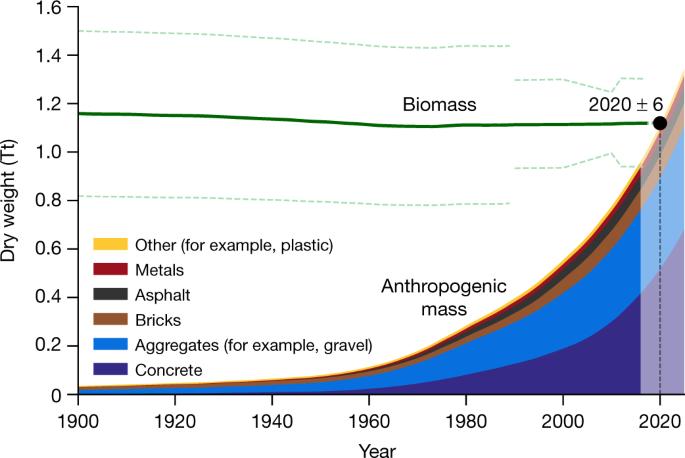全球人为生物量超过所有生物量
IF 50.5
1区 综合性期刊
Q1 MULTIDISCIPLINARY SCIENCES
引用次数: 233
摘要
人类已成为塑造地球面貌的主导力量1-9。一个新出现的问题是,人类活动的总体物质产出与总体自然生物量相比如何。在此,我们对人类制造的物质(称为 "人为物质")进行量化,并将其与地球上的总体生物量(目前约为 1.1 太吨10,11)进行比较。我们发现,地球正处于交叉点;到 2020 (± 6)年,最近大约每 20 年翻一番的人为生物量将超过全球所有生物量。平均而言,全球每个人每周产生的人为质量相当于他或她的体重。人类事业的这一量化,为人类所引发的 "人类世 "时代提供了基于质量的定量和象征性特征。随着时间的推移,对全球总生物量(所有生物的质量)和人为质量(人类制造的无生命物体所蕴含的质量)的估算表明,我们大致处于人为质量超过总生物量的时间点。本文章由计算机程序翻译,如有差异,请以英文原文为准。

Global human-made mass exceeds all living biomass
Humanity has become a dominant force in shaping the face of Earth1–9. An emerging question is how the overall material output of human activities compares to the overall natural biomass. Here we quantify the human-made mass, referred to as ‘anthropogenic mass’, and compare it to the overall living biomass on Earth, which currently equals approximately 1.1 teratonnes10,11. We find that Earth is exactly at the crossover point; in the year 2020 (± 6), the anthropogenic mass, which has recently doubled roughly every 20 years, will surpass all global living biomass. On average, for each person on the globe, anthropogenic mass equal to more than his or her bodyweight is produced every week. This quantification of the human enterprise gives a mass-based quantitative and symbolic characterization of the human-induced epoch of the Anthropocene. Estimates of global total biomass (the mass of all living things) and anthopogenic mass (the mass embedded in inanimate objects made by humans) over time show that we are roughly at the timepoint when anthropogenic mass exceeds total biomass.
求助全文
通过发布文献求助,成功后即可免费获取论文全文。
去求助
来源期刊

Nature
综合性期刊-综合性期刊
CiteScore
90.00
自引率
1.20%
发文量
3652
审稿时长
3 months
期刊介绍:
Nature is a prestigious international journal that publishes peer-reviewed research in various scientific and technological fields. The selection of articles is based on criteria such as originality, importance, interdisciplinary relevance, timeliness, accessibility, elegance, and surprising conclusions. In addition to showcasing significant scientific advances, Nature delivers rapid, authoritative, insightful news, and interpretation of current and upcoming trends impacting science, scientists, and the broader public. The journal serves a dual purpose: firstly, to promptly share noteworthy scientific advances and foster discussions among scientists, and secondly, to ensure the swift dissemination of scientific results globally, emphasizing their significance for knowledge, culture, and daily life.
 求助内容:
求助内容: 应助结果提醒方式:
应助结果提醒方式:


